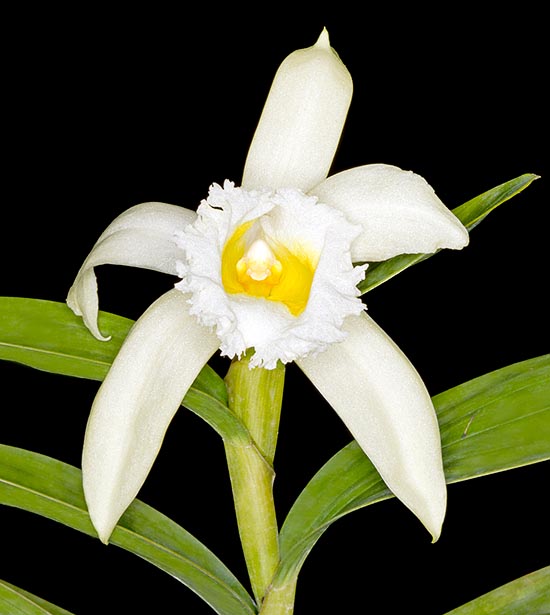Family : Orchidaceae

Text © Pietro Puccio

English translation by Mario Beltramini

Sobralia macrophylla comes from tropical America where grows in the humid forests by the water streams. Terrestrial or epiphytic is cespitous with only one 10-12 cm flower © Mazza
The genus is honoured to the Spanish physician and botanist Francisco Sobral; the name of the species is the combination of the Greek adjective “μακρός” (macrόs) = big, long and of the substantive “φύλλον” (phyllon) = leaf, with obvious reference.
The Sobralia macrophylla Rchb.f. (1852) is a terrestrial or epiphytic species, cespitous, with thin erect stems, up to 60-80 cm tall and of 0,5-0,8 cm of diametrer, provided in the upper part of alternate ovate-elliptic leaves with pointed apex, flat or slightly concave, plicate, veined, thin, 12-18 cm long and 4-8 cm broad, of decreasing dimensions towards the apex, of pale green colour, glossy above. Terminal inflorescence carrying one single flower, of about 10-12 cm of diametrer, with elliptic-lanceolate sepals and petals, 6-8 cm long and about 1,3 cm broad, cream white to pale yellow, obovate labellum, about 7 cm long and 3,5 cm broad, wrapping the column at the base, with wavy and fringed margin, of the same colour as sepals and petals with yellow spot at the base. The flowers last one day only and are slightly perfumed.
It reproduces by seed, in vitro, and by division at the time of the vegetative restart. In the tropical and humid subtropical climate zones it can be cultivated in open air as terrestrial in very luminous position, also direct sun light in the morning, on draining soil rich of organic substance maintained humid almost constantly. Elsewhere, it is to be cultivated in pot utilizing an organic substratum, like coir, with medium-high temperatures in summer, 25-32 °C, slightly cooler in winter, regular and abundant waterings in summer, but without stagnations, slightly more spaced in winter, but without allowing the loam to dry up completely, using rainwater, demineralized or by reverse osmosis. Weekly fertilizations in summer, using preferably a hydrosoluble product, with microelements, at half the dosage marked on the package, to be reduced to a monthly frequency in winter. The repottings are to be done when strictly necessary by the vegetative restart.
The species is reported in the appendix II of the CITES (species whose trade is internationally ruled).
Synonyms : Sobralia chlorantha Hook. (1852); Cattleya chlorantha (Hook.) Beer (1854); Cyathoglottis macrantha Lem. (1854).
→ For general notions about ORCHIDACEAE please click here.
